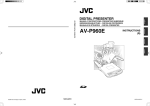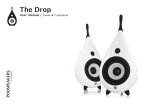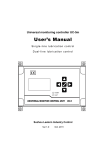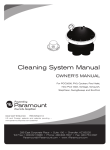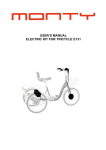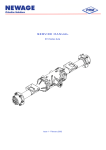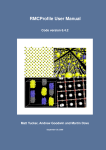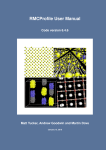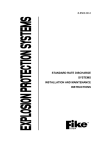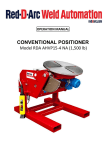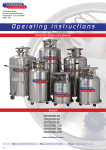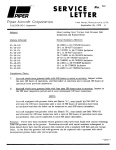Download Fuel Filtration Operating & service manual
Transcript
FRB-50499-240 Fuel Filtration Operating & service manual Contents page Specification and consumable 1 6 Model FRB-50499 Width 2080 mm Depth 1100 mm Height 1700 mm Frame Mild Steel Finish French Blue Voltage 240 VAC ±5% Single Phase Frequency 50 Hz ±2% Current 32 Amps Power 2.2 kW Motor protection Pump 1 Single phase motors are provided with an automatic thermal protection switch Self priming progressing cavity type Noise level <70dB @ 1m from the pump under normal working conditions Duty cycle Continuous Filtration Water removal / Particulate removal Filter Indicator Visual differential pressure Pressure 10 bar max Temperature -5°C - 80°C Flow 100 L/min @ 3 bar Medium Diesel Environment IP55 Connections 2” BSP Over pressure safety Consumables Electrical 3.5 Bar | Mechanical 4 Bar Rating Part No. 10 micron Nom FT-19PP010-2GYEP 5 micron Nom FT-19PP005-2GYEP High Efficiency 1 micron Nom FT-19HE001-2GYEP Filtasorb 2 1 micron Nom FT-FA-02-001 Filter Bags FRB-50499-240 Fluid circuit diagram The FRB-50499 is a mobile filtration system for the removal of particulate and water contamination from diesel fuel. The system is capable of delivering contaminated fuel up to a very respectable 100 L/min through a robust progressive cavity pump. The fuel is then passed through 2 x 2 sets of particulate removal cells in parallel, and then through a further 2 cells which can be fitted with our water removal media (Filtasorb 2) this gives a staged filtration approach. The system has been designed to run through all the filter cells as well as separately through 2 individual banks of filters, this allows the user to carry out a filter media change or any other necessary maintenance to each bank of filters.... meaning the unit can still run without any downtime. There are sample points (SPI/SP2/SP3) at various stages of the filtration process, allowing the user to check the cleanliness of the fuel in conjunction with Sigmas FS9001 Partical Counter. The system has an electrical over pressure system feature which is in turn protected by a mechanical bypass which will recircuit the fuel should the system pressure exceed 4 Bar. A differential pressure gauge for each filter cell is mounted on the frame to allow the user to monitor the life span of the filter media, a simple traffic light system is used to gauge the remaining life (Green, Amber, Red). It is recommended the media be changed when the needle is towards the end of the amber part of the gauge. 8 2 Product Anatomy Frame French Blue ” BSP Valved 2” Aux Inlet BSP Valved Connection 2” BSP Valved FRB-50499-240 Connection OPERATIONAL INSTRUCTIONS: 1) Connect the unit to a suitable 240 VAC, 32 amp supply. 2) Move the isolator to the ON position, the SUPPLY ON indicator will illuminate white. 3) Make sure all physical hose connections are made and the appropriate valves are open (see circuit diagram). 4) Press the GREEN PUMP START button, the PUMP RUNNING indicator will illuminate green.5) To stop the pump press the RED PUMP STOP button. FAULT CONDITIONS: The following conditions will cause the pump to stop and the FAULT LED’s to illuminate. To start the pump after a fault a manual reset is required, this is done by correcting the fault then pressing the RESET button. 1. 2. High Pressure indicator will illuminate AMBER Bund Alarm indicator will illuminate AMBER Any activation of either Emergency Stop buttons requires a manual reset of the system, this is done by resetting the E-stop switch (twist until it pops out) and pushing the E-STOP RESET button. 10 FRB-50499-240 Installation & operating instructions Bag filter housing This housing is suitable at the operating parameters stated, for all liquids classified as Group 2. This fluid group is as defined in the European Pressure Equipment Directive 97/23/EC. Design Data: Working Temperature: Maximum Working Pressure: Vent: Max.: 110°C Liquid: 10Bar g Connections: Inlet: the higher of the two larger connections Outlet: the lower of the two larger connections located in the lid of the housing Drain: located in the bottom Installation: Vent: Fit the blanking cap/plug (supplied) or the vent and gauge kit as appropriate to the lid. Seal with the aid of PTFE tape or an appropriate sealant as required. Inlet/Outlet: Connect the inlet and outlet pipework to the housing connections. For threaded connections use PTFE tape or an appropriate sealant as a seal. For flanged connections use a suitable gasket and for dairy connections use the correct sealing ring. It is important that the pipe work to and from the filter is adequately supported. BEFORE OPERATING WE RECOMMEND THAT THE FILTER IS FLUSHED THOROUGHLY. **IMPORTANT SAFETY NOTES-PLEASE READ BEFORE USING THIS HOUSING** 1. 2. 3. 4. 5. 6. Never attempt to open the housing whilst under pressure. Never operate the housing outside of its permitted operating parameters as stated (i.e. over pressure, under vacuum, over or under temperature). Housings using Vee clamps should not be used in cyclic pressure or shock load environments, or where highly viscous fluids could solidify the closure seal. For safety, it is recommended that a pressure relief device is installed in the system to prevent overpressurisation. Never use the housing for fluids other than those it is rated for and ensure that the housing & seal materials are compatible with the process fluid. Care must be taken to protect operators from hot surfaces if the housing is being run at high temperatures. 7. Failure of the filter housing could result from misuse - please ensure that these installation, operating & maintenance procedures are strictly adhered to. The following factors have not been considered in the design of this housing, as they are either negligible or not considered appropriate for this product, unless specifically stated: 1. Static pressure/head 2. Traffic, wind and earthquake loading 3. Decomposition effects of unstable fluids 4. Creep, fatigue and corrosion allowances 5. External fire Operation: IMPORTANT: ALWAYS ENSURE THAT THE SYSTEM IS NOT UNDER PRESSURE BEFORE OPENING THE HOUSING FRB-50499-240 Opening the filter - For housings with a Bolted closure If the filter housing has been in service, refer to the instructions given in the section “Removing the Filter from 12 FRB-50499-240 Service”. Unscrew the clamp bolts with a suitable spanner. Swing the clamps clear of the cover. Remove the lid and ‘O’-ring. Store them in a safe place where they cannot get dirty or damaged. Remove the basket compression plate. Fitting the Perforated Basket The housing is supplied with a perforated bag support basket. There is an inner gasket fitted under the basket. Check the ‘O’-ring groove and inner gasket for any damage, and place inner gasket in the groove. Place the basket into position ensuring that the inner gasket does not become dislodged. Fitting the Filter Bags Push the bag into the basket that is situated in the housing and check that the filter bag ring is fitted flush to the basket flare. Position the bag compression plate onto the top of the bag ring, with the large plate fitting against the bag in the basket lip. This will compress the bag and basket against the inner gasket. Closing the Filter Housing - For housings with a Bolted closure Check the housing top ring and groove, the ‘O’-ring and lid for any dirt or damage. Clean away any foreign objects and replace defective parts as necessary. Place the ‘O’-ring into the groove at the top of the housing. Position the lid evenly over the housing ensuring the seal is not disturbed. Swing the screw clamps up into position ensuring that the clamp locates correctly in the grooves on both the lid and housing top ring. Screw the clamps down evenly. Before tightening ensure the lid is set squarely on the housing top ring. Finally nip down the screw clamps with a spanner in a diagonal basis across the filter housing. DO NOT over tighten. Putting the Filter into Service Ensure the inlet and outlet valves are shut. Ensure that the drain valves (if fitted) are closed or the drain plugs are fitted. Open the vent valve or plug. Gradually~ open the inlet valve on the upstream side of the filter housing whilst ensuring that the down stream valve remains closed. As the housing fills, air will be expelled from the vent. When all the air has been expelled, fluid will begin to flow from the vent. For safety reasons, it is important to ensure that vent and drain connections are secure and that released fluid is disposed of to an appropriate drain or container. Appropriate measures should be taken if the liquid is hazardous. Close the vent valve or plug, then slowly open the outlet valve-the filter is now in service and no attempt should be made to open the cover. Regular venting of the housing, by opening the vent to permit any trapped air to vent to atmosphere, will maintain the operating efficiency of the filter. For safety reasons, it is important to ensure that venting is ONLY performed via a valve, that the valve is opened with extreme care and that released fluid is disposed of to an appropriate drain or container. Appropriate measures should be taken if the liquid is hazardous. The filter can be operated until the increase in the pressure differential across the filter bag reaches approximately 1.5 bar g (25psi), at this point the filter bag should be replaced. Removing the Filter from Service Close the outlet valve Close the inlet valve Caution- the filter housing will still be under pressure at this point. Before opening the filter housing, the pressure must be relieved. This can be done either by carefully opening the vent valve or plug or the drain valve or plug, whichever is most appropriate. 13 FRB-50499-240 Before opening the closure, open both the dirty drain and clean drain valves or plugs to allow all of the fluid to drain out of the housing. The vent must be open to allow the housing to drain properly. If the fluid is hazardous, appropriate measures should be taken before opening the closure. For safety reasons it is important to ensure that vent and drain connections (such as any valves or hoses) are secure and that released fluid is disposed of to an appropriate drain or container. Replacing the Filter bags Open the filter housing according to the instructions given in the section “Opening the filter housing” The new filter bags should be installed according to the instructions described under “Fitting the Filter Bags”. Spent Filter Bag Disposal The spent filter bags should be disposed of in a responsible manner. The filter itself can be disposed of by incineration or as landfill by an authorized contractor; however, it is important for the user to check how the contaminant contained in the filter should be disposed of. Maintenance The filter housing will require very little maintenance. The outer surface should be kept clean and free from dirt. This will prevent contamination of the filter during bag change. The Vee clamp should be maintained as follows: A small amount of a suitable lubricant should be used on the sliding surfaces of the clamp. The ‘T’ bar thread must periodically greased. We recommend the use of a molybdenum based grease which will adhere to the thread. Binding of the thread could occur if they are not lubricated regularly. Inspect the ‘O’-rings each time the filter housing is opened and replace as required. The housing must be checked for any visible signs of corrosion or wear damage internally and externally on a routine basis. Internal examination should be carried out via the housing closure. 6. Always use genuine ROTO spares for sustained pump performance and longer life of critical parts. DON’TS 1. Never run the pump in a dry condition even for a few revolutions otherwise the rotor will damage the stator immediately. 2. Never run the pump against a closed inlet or outlet valve. 3. Never use foot valve for slurry applications. 4. Never vary flow rate by throttling suction and delivery line. 5. Never exceed recommended pump speed. 6. Never reverse the recommended direction of rotation of pump without consulting ROTO. 7. Never use local made or spurious spares that look alike but do not meet material standards or dimensional accuracy affecting life of critical components and performance of pump. 8. Care is required when adjusting the gland while pump is running. COMMISSIONING - All nuts and bolts, securing flanges and base mounting fixtures, must be checked for tightness before operation. To eliminate vibration, the pump must be correctly aligned with the drive unit and the guards must be securely fixed in position. All the pipelines must be independently supported and use of expansion joints is desirable to eliminate the transmission of vibrations and stresses to the pipelines. When commissioning the plant, all the joints in the system must be checked thoroughly for leakage. If on starting, the pump does not appear to operate correctly, the pump must be shut down immediately and the cause of the malfunctioning must be established before operations are recommenced. It is recommended that depending upon plant system operation either a combined vacuum gauge and pressure gauge, or a vacuum gauge only, be fitted to the pump inlet port and a pressure gauge fitted to the outlet port to continuously monitor the pump operating conditions. It is further recommended that a pressure relief valve of adequate capacity should be installed on the discharge side of the pump. START UP/RUNNING DRY RUNNING - Pumps must be filled with liquid before starting (A threaded plug has been provided on the top of the pump housing for this purpose). The initial filling is not for priming purpose, but to provide the necessary lubrication of the stator until the pump primes itself. When the pump is stopped, sufficient liquid is normally trapped between the pumping elements to provide the necessary lubrication for restarting. If, however, the pump has been left standing for a long time or has been dismantled, it must be refilled with liquid and given a few turns before starting, to get sufficient lubrication between the rotor and stator. If the pumping liquid is hazardous, then extreme care must be taken while initial filling of the pump using all safety and precautionary measures. NEVER RUN THE PUMP IN A DRY CONDITION EVEN FOR A FEW REVOLUTIONS OTHERWISE THE STATOR WILL BE DAMAGED IMMEDIATELY 14 FRB-50499-240 INSTALLATION, OPERATION & MAINTENANCE INSTRUCTIONS INSTALLATION, OPERATION & MAINTENANCE INSTRUCTIONS GLAND PACKING The pump is normally fitted with gland packing, which required final adjustment during initial running period. Under normal working conditions the gland rings are to be tightened in a manner to permit a slight drip from the gland. This enhances life of the shaft as well as of gland packing. It is important to note that the gland packing never be over tightened to arrest the leakage completely. This can lead to excessive heat generation that can cause permanent damage to shaft and packing. Adjustment by tightening should only be made when the pump is running. Indication of slight drip from the gland packing will only be evident if the pump is running delivery on gland or with suction on gland with a flooded suction. If the pump runs with a vacuum on the gland, a flushing connection (or greaser) with lantern ring is recommended. Where lantern rings are fitted in stuffing box; the flushing liquid inlet or outlet should be connected for proper circulation of the liquid. MECHANICAL SEAL - When the pump is supplied with mechanical seal, it may be necessary to ensure proper flushing & quenching arrangement as per the seal manufacturer’s recommendations, enclosed with this manual. GLAND GUARDS - In the interest of safety of personnel and in compliance with statutory requirements of various countries, the pumps are fitted with gland-guards that can be easily removed for adjustment of gland sealing. It is responsibility of the user to make sure that the guards are placed back in position after necessary adjustments have been made. LUBRICATION - The pump should be inspected periodically for lubrication of bearings to see if grease replenishment is required, and if so, grease should be added in accordance with the instructions given in assembly procedure. MAINTENANCE OF WEARING COMPONENTS ROTORS AND STATOR - The wear rate of these components depends on many factors, such as product abrasiveness, speed, pressure etc. One or possibly both items will need to be replaced, when the pump performance has reduced to an unacceptable level. DRIVE SHAFT – STUFFING BOX - The wear rate under gland area of the drive shaft depends on various factors like product abrasiveness, extent of tightening of the packing and speed of the pump. Periodic inspection and maintenance of the gland will maximize the life of the shaft. Replacement of the gland packing or both the gland packing and the drive shaft will be necessary when the shaft sealing becomes difficult to achieve. UNIVERSAL JOINT - Universal joints should be examined when the pump is dismantled for any reason or for routine maintenance during periods of regular scheduled equipment down time. The joints should be cleaned and renewed with fresh grease before assembly. Use only recommended grease as per specifications in this manual. PUMPSET - When a pump unit is dismantled and reassembled, it has to be ensured that the following steps, as applicable, are covered 1. Correct alignment of pump and driver. 2. Use of appropriate couplings and bushes. 3. Use of appropriate belts and pulleys. PUMP OPERATING TEMPERATURE - The surface temperature range depends upon factors like ambient temperature and temperature of the fluid being pumped. If the external pump surface temperature goes above 500C, personnel must be made aware of these and suitable warnings or guarding must be employed. EXPLOSIVE PRODUCTS/ HAZARDOUS ATMOSPHERE In certain instances, the product being pumped may be of a hazardous nature. In these installations, considerations must be given to provide suitable protection and appropriate warnings to safeguard personnel and plant. INSPECTION ADJUSTMENT OF GLAND PACKING - The gland packing should be inspected every day after starting the pump. Remove the gland guards to check the leakage. If the sealing is not proper it must be adjusted by tightening or loosening of gland nuts to attain the preferred level of sealing. Excessive tightening should be avoided, as it would result in excessive heat generation leading to permanent damage of both the packing and the drive shaft. Experienced personnel should carry gland adjustment carefully so that safety of the personnel is not endangered. SPECIAL INSTRUCTIONS PERIODIC INSPECTION - To avoid unexpected failure of the pump, it is important that the pump is periodically dismantled and routine inspection of the pump is carried out as follows: Inspection of the pumping elements for wear and tear, after every six months or if the discharge falls below acceptable levels. Periodic bearings and universal joints inspection is necessary to maintain optimum performance. The most appropriate time to inspect is during periods of regular scheduled downtime for routine maintenance or for any other reason ROTATION The RNA/RNB Series pumps are capable of taking rotation in both the directions but if a change of direction is required, consult ROTO or its authorized agents before doing so. LUBRCATION Bearings: Pumps should be periodically inspected to see if grease replenishment is required. If so, bearings should be cleaned and repacked with grease until the bearing chambers are one third full with grease. Use one of the following recommended or equivalent grease: 1. SHELL Alvaina R3 2. BP Energrease LS# 3. Castro Spheerol AP# 4. Mobilux 3 UNIVERSAL JOINTS 15 FRB-50499-240 The pin type universal coupling should be lubricated when the pump is dismantled due to some reason. To do so pack entire space between the coupling rod head and rotor or drive shaft bore with one of the following recommended or equivalent grease,after cleaning the components. 1. 2. 3. 4. Shell Alvania grease 2 Mobilux 2 MP Grease 2 Castrol Spheerol AP2 Whenever Boot seal of EPDM materials are recommended or used, please ensure that only the following Silicone Grease compound is used for such applications. 1. 2. MOLYCOTE 7 COMPOUND OKS 1110 GREASE NOTE: The above Greases also comply with food applications. 16 FRB-50499-240 Before dismantling DISMANTLING & ASSEMBLY INSTRUCTIONS FOR isolate all electrical RMCA / RMGA – 641 PUMPS circuits. Close all isolation 9. Unscrew the Hex Head Nut (42) and collect Spring valves on the suction and discharge to the pumps are prevention Washer (43) & Punched Washer (44). Take out the of liquid escaping from the pipe work system. The persons carrying Pump Lantern (1200) and also remove the Tap End Stud out the work should be adequately trained in general workshop (41). practice, relevant to the class of work involved & taking care of safety. Note: DISMANTLING INSTRUCTIONS: 1. 2. 3. Unscrew the Hex. Nuts (15) fitted to the Tie Rods (7710) and remove the Spring Washers (16), Plain Washer (36), End Cover (5310), Tie Rods (7710) and Foot (0760). To remove the Bonded Stator (2220) from Pump Housing (5020) , pour some water or soap solution into the Bonded Stator (2220) through the opening in the Pump Housing (5020) to ease the stiffness. Move out the Bonded Stator from the Rotor (2500) by rolling in the clockwise Direction looking from the drive end. Unscrew the Four Hex. Head Bolts and Nuts (21,22), holding the Pump Housing (5020) to Stuffing Box (5810) and withdraw the Spring Washers (23), Plain Washers (37), Pump Housing (5020), taking care of any undue rubbing on the Rotor (2500) & Coupling Rod (2610). Rotor may be protected by covering with some soft material like cloth. 4. In order to dismantle the Rotor (2500), Universal Joints (20) have to be dismantled. Remove the External Circlips (06), Pin Retainer Sleeves (2820) Boot Seal Retainers (2810) and drag out the Boot Seal (1510) and collect the grease. Remove the Spring Pins (01) and knock out the UJPins (2920) from UJ Head (4010). 5. Dismantle the Rotor (2500) from Coupling Rod (2610). Remove UJ Bushes (2730) and UJ Block (4110). Now knock out the C/Rod Pins (2910) from UJ Heads (4010), holding Rotor (2500) and Coupling Rod (2610). Remove UJ Heads (4010) and O-Rings (02,03,04) from UJ Head and Stub Shaft / Coupling Rod. 6. Repeat the same for other Universal Joint (20), Coupling Rod (2610) and Stub Shaft (4400). 7. Unscrew the four Hex. Nut, Stud, Spring Washer (09,101,11), Slip out the Stuffing Box (5810) and Gland (5410) assembly and unscrew two Hex Nuts and Studs (07,08) to remove the Gland (5410) and Gland Packing (7500). 1. Clean all the parts and check them for wear / damage. The worn out / damaged parts should be replaced with original ROTO Spares. 2. In order to dismantled parts use suitable antirust compound on the Metallic surface of component. ASSEMBLY INSTRUCTIONS: 1. Align Stub Shaft in such away so that the motor shaft hole is in line with Stub Shaft locating hole. Insert Dowel Pin (2930) through Stub Shaft and motor shaft. Locate Pin Retainer over Dowel Pin over Dowel Pin and Secure tightly with Set Screw (45). 2. Assemble Geared Motor (40), locating it on Pump Lantern (1200) and securing with Hex Bolts / Studs, Nuts and Washers (41,42,43,44), while keeping the Geared Motor Supported from overhead. 3. Fill the Gland Packing (7500) in the Stuffing Box (5810) and locate the gland (5410) as shown. Secure the Gland (5410) and Stuffing Box (5810) by Studs (07) & Hex Nuts (08). Insert this Sub assembly over the Stub Shaft (4400). Secure the Stuffing Box (5810) to Pump Lantern (1200) by four Hex Nuts, Studs and Spring Washers (09,10 & 11 resp.) as shown in the C.S.Drawing). In case of Mechanical Seal, proceed as under: (Ref. RN-10-144) Locate Stationary Seat with Seal Ring in the Seal Plate (5451) in position applying even pressure. In case of Teflon O-Ring with Stationary Seat, fitment shall be made by applying pressure on to the Stationary Seat Under a small press or Drill Machine Spindle, using a soft pack on the face of the seat while driving the stationary seat in the Seal Plate (5451). • Fit the Seal Plat with Mechanical Seal Housing (5861) after putting the ‘O’ Ring (33) and locate the assembly in place on the Pump Lantern (1200). Measure distance ‘L1’ from Stub Shaft (4400) end to face of stationary seat. Now take out the Mechanical Seal Housing assembly with seal plate. If operating length of Mechanical Seal is ‘L2’ mark a distance ‘L’ on the Stub Shaft (4400) equal to ‘L1-L2’ from UJ end of the Stub Shaft. • Take out Seal Plate (5451) from the Seal Housing (5861) by unscrewing the nuts (32). • Slide over the Seal Plate (5451) with Stationary Seat on to the Stub Shaft (4400) towards Pump Lantern (1200) side. • Insert Rotary Part of the mechanical Sea onto the Stub Shaft (4400), taking extreme care not to damage any part of the seal. Note: In case of Mechanical Seal (Ref. RN-10-144), unscrew Hex Nuts (32), connecting Seal Plate (5451) & Mechanical Seal Housing (5861). Remove Mechanical Seal Housing (5861) & collect ‘O’ Ring (33). Now remove setscrews from drive collar of Mechanical Seal (30) and take out Mechanical Seal. Remove Seal Plate (5451) along with Stationary Seat of Mechanical Seal. 8. Unscrew four Hex Socket Set Screw (45) from Pin retainer (2850) & remove the Pin Retainer (2850) sliding towards the Head side. Knock out the Dowel pin (2930) and remove the Stub Shaft (4400). 17 FRB-50499-240 DISMANTLING & ASSEMBLY INSTRUCTIONS FOR RMCA / RMGA – 641 PUMPS • • 4. Now tight the Drive Collar of Mechanical Seal in place, on the mark at distance ‘L’ over the Stub Shaft, with Setscrews. In case Stub Shaft is Hard Chrome Plated, tight the Setscrews on the Stub Shaft after removing plating at places to be screwed, by a small hand grinder. Now fit Mechanical Seal Housing (5861) between Pump Housing (5020) and Pump Lantern (1200). Pull Seal Plate (5451) to the Seal Housing (5861) and tight in place with Studs (31), Spring Washers (34) & Hex Nuts (32). Secure the Mechanical Seal Housing (5861) to Pump Lantern (1200) by four Hex Nuts, Studs and Spring Washers (09,10,11 resp.). To proceed further, assembly of Universal Joint (20) has to be done as under: Clean all the internal surface of U.J. Head (4010) and place the ‘O’ Rings (02,04) in their respective grooves. Also place the ‘O’ Rings (03) in the Stub Shaft groove. Place one External Circlip (06), Pin Retainer Sleeve (2820) and Boot Seal Retainer (2810) on Stub Shaft (4400), Stuffing Box Side. Fit the U.J. Head (4010) on Stub Shaft (4400) and insert the C/Rod Pin (2910) after aligning the hole in the U.J. Head (4010) and Stub Shaft (4400). 5. Apply some grease on the OD pf U.J Bush (2730) and insert it in the holes of U.J. Head (4010) taking care that scratches does not comes on the Bush ID or OD while fitting. 6. Offer the U.J. Block (2730) in another U.J. Head (4010) mounted at Stub Shaft (4400), after aligning the U.J. Block (4110) and Bush (2730) holes, insert the U.J. Pin (2920) and lock it by the Spring Pin (01). 7. Fit the U.J Bush (2730) in another U.J Head (4010) after placing ‘O’ Ring (04 & 02) and offer it to other side of U.J Block (4110) (already assembled in step 7), insert the U.J .Pin (2920) after aligning the U.J Bush (2730) and U.J Block (4110) holes and lock it by Spring Pin (01). Now drag the Boot Seal (1510) at its position taking care that it rests on the grooves in U.J Head (4010). 8. Insert External Circlip (06). Pin Retainer Sleeve (2820) and Boot Seal Retainer (2810) respectively on the Coupling Rod (2610) and place ‘O’ ring (03) in the Coupling Rod groove. 9. Fill the grease inside the U.J (20) fitted on the Stub Shaft (4400) and insert the Coupling Rod (2610) in the U.J Head care of alignment of the C/Rod Pin holes at Coupling Rod and U.J Head, now insert Coupling Rod Pin (2910). Washer (11) , locating Stuffing Box (5810) in position between Pump Lantern and Pump Housing. 14. To assemble the Stator (2220) pour some water or soap solution into the Stator to ease the stiffness. Push the Stator over the Rotor forcing it towards the Pump Housing by rolling it over the Rotor (2500) in the Anticlockwise Direction looking from the drive end, till it butts with the Stator Support Ring (6220). 15. Place the two Foot (0760) in the position as shown and offer the End Cover (5310) to Stator (2220). Thread up Nut and Washers (15,16,36) each on topsides. Insert these Tie Rods in the holes in End Cover (5310) and Pump Housing (5020). Also insert two Tie Rods (7710) on top side tighten the four Tie Rods (7710) by with Nuts, Spring Washers and Plain Washers (15,16,36). 16. After total assembly of the pump, put it on a flat surface to check that Foot (0760) are lying co-planner and also place the Gland Guards (7620). Ensure that all the fasteners except Gland Nuts (08) are tightened properly. 10. Place the Boot Seal Retainer (2810), Pin Retainer Sleeve (2820) and secure it with External Circlip (06) at both side of the Universal joint. 11. To assemble U.J (20) on the Rotor (2500) repeat Steps 5 to 8. 12. Repeat the steps 9 to 11 to assemble Coupling Rod (2610) and Rotor (2500). 13. Placing the Stuffing Box Gasket (8120) at its location, drag the Pump Housing (5020) without touching the Rotor (2500). And connect it by tightening the Hex. Nut (10) after placing the Hex Head Bolts (09), Punched Washer (37) & Spring 18 19














